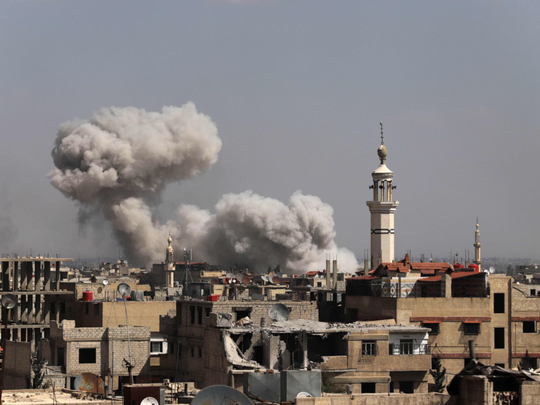
Haven’t the Syrian people suffered enough? What began as a popular uprising against a dictator on the lines of others in the region during 2011 has delivered only misery for the population. It is a tough pill to swallow but the undeniable fact remains that due to Moscow’s military support Bashar Al Assad is going nowhere.
The regime cracked down on insurgents mercilessly and has now regained control of most of the country including almost all major cities. The rebel stronghold of Eastern Ghouta near Damascus has been pummelled by Syrian and Russian warplanes since February 18. Up to 1,000 men, women and children have been killed. Others are starving or lacking lifesaving medicines. News reports suggest that government forces have now taken half of the besieged area.
Civilians have been offered safe passage to Damascus but few have taken that option fearing arrest or torture. Militant groups, among them Jaish Al Islam and Hayat Tahrir Al Sham, are being permitted to leave with their families and light weapons to the Syrian province of Idlib following negotiations with the regime via the United Nations and other parties.
The same policy was used to evacuate Raqqa from Daesh [the self-proclaimed Islamic State of Iraq and the Levant] terrorists and before it Aleppo from rebel forces. Those cities are being rebuilt and residents are regaining a sense of normality or so photographs and videos appear to indicate. They have not gained freedom. They have not won human rights or free expression. However, they have escaped the bombs and the carnage with their lives.
Unfortunately, there may be more horrors of war in the pipeline. In January, the US Secretary of State Rex Tillerson announced America’s goals in Syria to secure US interests. These include defeating terrorists, putting an end to Iranian influence and the toppling of the Al Assad regime.
Refugees will be facilitated to return home on a voluntary basis, he said. But isn’t ridding the country of Al Assad and providing a safe environment for refugees mutually exclusive unless he chooses to head for the hills.
President Vladimir Putin is not about to abandon the regime at America’s request and the United Nations Security Council is impotent to pass resolutions to that effect given Russia’s power of veto. Tillerson asserts that US troops will remain in northern Syria which is under the control of the Syrian Democratic Forces that includes Arab and Kurdish militia.
The hiccup is this. Those same Kurdish fighters who have served as a ground force under US direction to successfully cleanse areas of terrorists are heading to the northwestern Afrin region to defend their brethren from a Turkish/Free Syrian Army onslaught targeting the YPG/PKK. They have appealed to their US partner to stop Turkey’s bombardments but the White House, caught between two allies, isn’t listening.
In other words, the Syrian people cannot yet breathe a sigh of relief. There could be more death and destruction on the horizon.
A recent report from the editor of Kuwait’s Al Jarida newspaper maintains that President Trump and Israeli Prime Minister Benjamin Netanyahu are collaborating on a plan to attack the regime and Iranian targets to block Iran from establishing a corridor from Lebanon to the Mediterranean via Syria — and would also entail joint military actions in Lebanon and Iraq. The trigger would be pulled if Al Assad is proven to have once again used chemical weapons.
In a perfect world Al Assad should have been packing his bags many years ago or should have been forcibly sent packing before Putin saw an opening and ran with it. Unfortunately, then US President Barack Obama blinked when it came to following through on his famous red line. Instead, he legitimised the regime with a deal on the disposal of Syria’s chemical weapons.
The dilemma is this. Trump has a gung-ho character and impulsive nature. He is known to act without giving thought to consequences. If the US and Israel launch strikes on Syria, Lebanon and Iraq, the entire region will be a casualty perhaps for many years, in terms of loss of life, treasure and faltering economies.
Iran has no business being in Syria and Israel will not tolerate its presence on its doorstep or that of Hezbollah with access to the Mediterranean. Arab states rightly view Iranian ambitions to dominate Arab countries as a major threat.
The US and Russia are vying to place Syria and its neighbours within their respective spheres of influence. A secondary concern is the well-being of the Syrian people.
Let’s face it, have there been any US military interventions in the Middle East that could be in any fashion termed successful; certainly not Afghanistan, Iraq or Libya.
Tragically, Syria has emerged as a battlefield for proxy conflicts serving not the Syrian people but the competing geopolitical interests of major powers whose emissaries cry crocodile tears in the UN for the plight of Syrian children.
The international community has messed up. The US and its allies stood on the sidelines when action was urgently needed and now Trump offers the prospect of serious action when Syrians are just beginning to see light at the end of a very dark tunnel.
There is one possible solution. Rather than begin yet another operation to oust Al Assad, Trump should hold his nose to bring him and his backer Putin on side with a combination of carrots and sticks. Together they can drive out Iranian militias and seal the door to Hezbollah. As former British Prime Minister Winston Churchill said, Jaw-Jaw is better than War-War. For the sake of humanity, in this case, I believe it is.
Linda S. Heard is an award-winning British political columnist and guest television commentator with a focus on the Middle East.












